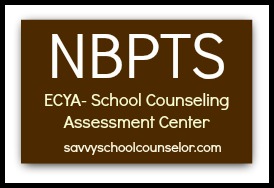National Boards: Assessment Center
 I recently received an email from a reader who asked about preparing for the School Counseling Assessment Center Exercises. I remember when I was preparing for the assessment exercises. I have never considered myself to be the best test taker, so I was somewhat stressed…Okay, I was VERY stressed! Because of this, I signed up to take the assessment in June so I would have the month of May and at least half of June to prepare. After writing all school year and submitting my four entries before the March 31st deadline, I gave myself the month of April off to recoup.
I recently received an email from a reader who asked about preparing for the School Counseling Assessment Center Exercises. I remember when I was preparing for the assessment exercises. I have never considered myself to be the best test taker, so I was somewhat stressed…Okay, I was VERY stressed! Because of this, I signed up to take the assessment in June so I would have the month of May and at least half of June to prepare. After writing all school year and submitting my four entries before the March 31st deadline, I gave myself the month of April off to recoup.
There were no “study guides” available (at least none that I was aware of) at the time I was a candidate for NBPTS. I’ve searched to see if guides are available now, but I haven’t turned up anything. (If anyone knows of one, let me know!) Therefore, I used the Assessment at a Glance provided on the NBPTS website.
There are six 30-minute assessments. They are completed on a computer with the countdown clock on the screen so you’ll know how much time you have left to work. You are given three assessments in a row, given a ten minute break, and then you’ll finish the other three. The following areas are addressed on the assessment and are taken directly from the Assessment at a Glance document:
Exercise 1: Human Growth and Development- In this exercise, you demonstrate knowledge of a specific human growth and development theory, and then apply that knowledge to a given developmental stage.
Exercise 2: School Counseling Program- In this exercise, you demonstrate knowledge of the development, implementation, and management of a school counseling program.
Exercise 3: Diverse Populations- In this exercise, you use knowledge of counseling diverse populations to apply counseling skills, techniques, and interventions to a student situation.
Exercise 4: Theory- In this exercise, you demonstrate knowledge of a counseling theory and theorist by describing the theory and applying it to a school counseling issue.
Exercise 5: Data and Planning- In this exercise, you demonstrate the ability to interpret and analyze the data provided, make appropriate recommendations for school improvement, then discuss the rationale and steps for implementation of the recommendations.
Exercise 6: Collaboration – In this exercise, you assess a student concern, then discuss the legal and ethical procedures and medical concerns to consider while creating a plan of collaboration to help the student succeed.
Again, I did not have a study guide, so pulled out text books and notes from graduate school to help me prepare for areas such as Human Growth and Development, Theory, and Diverse Populations. I had an excellent Theories professor. I remembered her giving us a template to assist with studying all of the key figures in counseling theory. I found the chart in my notebook and created one to use for my assessment preparation. On the chart, for each theory, you will list the key figures, key concepts, time orientation, therapeutic goals, therapeutic relationship, and a few other areas. Using this was very helpful for me when reviewing the theorists. Click HERE to download a copy of the chart. I wrote in the boxes. However, if you would like the Word document to manipulate it yourself, just contact me, and I’ll be happy to forward it to you.
I studied the two sample exercises for School Counseling Program and Diverse Populations. Use those examples!!! They are very helpful. Think about how you would respond to each of the prompts. These samples are on pages 6 and 7. If you are familiar with and use the ASCA National Model, you should have no problem with Exercise 2: School Counseling Program. You’ll want to refresh your memory about counseling different cultures for the Diverse Populations exercise. I reviewed my grad school notes from my multicultural counseling course to prepare for that assessment.
Also, be sure to brush up on those key Human Growth and Development theories. Just as it says above, be ready to apply the theory to a given developmental stage.
I personally did not do any lengthy preparation for the data and planning assessment. I knew how to analyze data, so I viewed that section as one where I would take the information and create a plan from it which is what I did and was fine.
Knowing my four entries weighed the heaviest and that I had test anxiety, I made sure I did the best I possibly could on my four written entries because not scoring well on one of those would have meant not certifying. The six assessments count 6.67% each for the overall score, so that gave me some wiggle room.
My One Fiasco
If I could have screamed, I would have! I knew that I could cut and paste as necessary in the assessment. I did cut and paste here and there. At one point, I cut an entire answer to a prompt, but when I went to paste it…you guessed it…it was no where to be found!! I had maybe 5-6 minutes left and had to re-create that answer from scratch. Talk about STRESS!!! I got through it, but I know my first answer had to have been much better. Be careful with cut and paste, you guys!!
Stick around! You can follow Savvy School Counselor with free email updates. You can also follow my TpT Store to keep up with my latest products and freebies.




13 Comments
Angelique Burris
That was awesome Vanessa! Thanks!
Diana Arroyo-Gonzalez
Hello,
Could you please send me a copy of your Word document to manipulate regarding the Counseling Theory Review Chart for the NBPTS? Thank you, Diana
Ruth Krochmalny
Can you send a copy of your grid for national boards? Thanks…..
Kristie Ford
Could you please email me a copy of your Word document regarding NBPTS assessment center exercises? I would greatly appreciate it. Thanks so much! 🙂 Kristie
Andre Wren
I test this Saturday and have been reviewing daily since mid May. I’ma finding that things are starting to click somewhat, but I fear that when I get to the assessment that I’ll clam up. I’m thinking of taking tomorrow off to kinda relax a bit. I have a grasp on the prominent theories (Erikson, Piaget, and Vygotsky) but my fear is that the prompt will deal with someone like Keller’s ARC or something off the wall. Wish me luck!!
Vanessa
You’ll do fine!! Best wishes to you!
elise
Do they ask about a specific theory and/or developmental theory or do they allow you to use your own knowledge of a particular theory and then I can apply it how I wish?
Vanessa
Hi, Elise. They will ask you about a specific theory and developmental theory.
Kendra
Hello Vanessa,
I am so happy to have stumbled upon your blog. As I consider taking “the next big step” towards NBCC your posts have been most informative. Thank you so much for your willingness to share your knowledge and time with all of us. I have began studying, just to get a heads up and would like to obtain a copy of the Counseling Theories Chart if you would oblige. Again, thank you so much for this valuable and straightforward information about the process. I will be reading. Many blessings.
Vanessa
Hi, Kendra! Thanks for your comment. The link is provided in the post. Look for the word “HERE” in pink letters. Here’s the link as well: https://savvyschoolcounselor.com/wp-content/uploads/2013/05/Counseling-Theory-Review.pdf
Heather Gonyea-Evans
Hi do you happen to have a copy of this with it filled in?
Vanessa
Hello, Heather. I’m afraid I do not. So sorry!
Pingback: